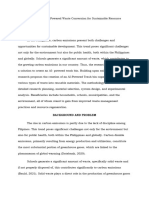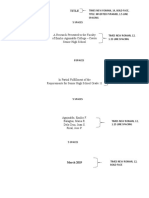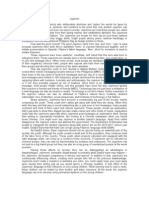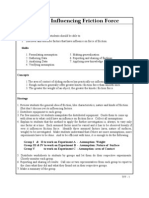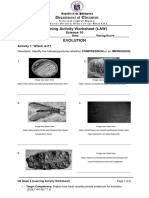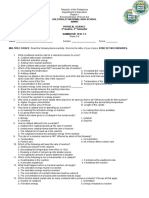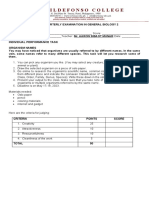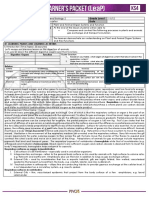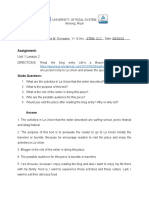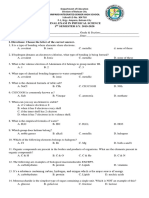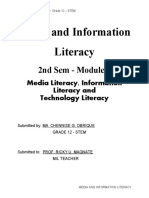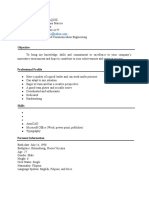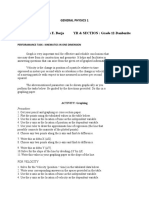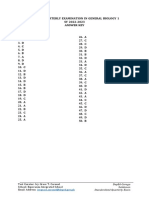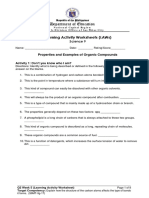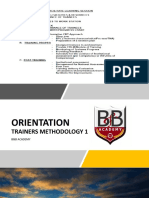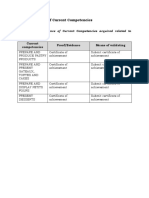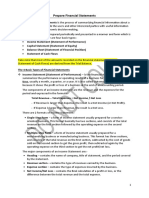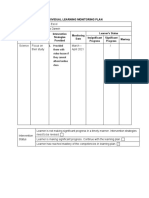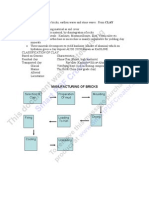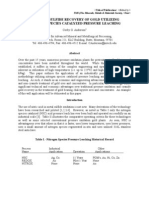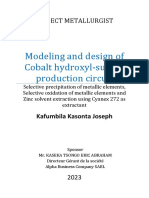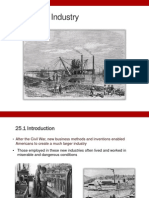Law of Conservation of Mass: Learning Activity Sheets Grade 10 - Science
Law of Conservation of Mass: Learning Activity Sheets Grade 10 - Science
Uploaded by
Cristina YusonCopyright:
Available Formats
Law of Conservation of Mass: Learning Activity Sheets Grade 10 - Science
Law of Conservation of Mass: Learning Activity Sheets Grade 10 - Science
Uploaded by
Cristina YusonOriginal Description:
Original Title
Copyright
Available Formats
Share this document
Did you find this document useful?
Is this content inappropriate?
Copyright:
Available Formats
Law of Conservation of Mass: Learning Activity Sheets Grade 10 - Science
Law of Conservation of Mass: Learning Activity Sheets Grade 10 - Science
Uploaded by
Cristina YusonCopyright:
Available Formats
LEARNING ACTIVITY SHEETS
Grade 10 – Science
__________________________________________________________________________________
Name: ______________ Date: ____________ Rating/Score: ________
LAW OF CONSERVATION OF MASS
PART I. "The Missing Link"
DIRECTIONS: Analyze the following situations and answer the guide questions.
A candle with paraffin wax and a wick is burning as it reacts with oxygen in the air.
After it was completely burned, you see some smoke (carbon dioxide gas) and
water vapor. Did you ever wonder what happens to the total mass of the reactants
before and after burning?
C25H52 (s) + 38O2 (g) → 25CO2 (g) + 26H2O (l)
Guide Questions:
1. What is the total mass of the candle wax and oxygen (reactants)?
2. What is the total mass of the carbon dioxide and water vapor (products)?
3. Describe the total mass of the reactants and the total mass of the products after the
burning process?
4. Does the total mass of the reactants and the total mass of the products appear to be
equal after chemical reaction or not? Why?
5. Why is it that you always end up with less paraffin wax after burning the candle than
when you started it?
PART II. "Weigh In Right!"
DIRECTIONS: Given the balanced chemical equations in the following scenarios, compute
for the total mass of the reactants and the total mass of the products.
Mass of the Mass of the
Scenarios/Reactions
Reactants Products
1. Rusting of iron
4Fe + 3O2 + 2H2O → 2Fe2O3 . H2O
__________________________________________________________________________________________
Specific Week: 5 and 6 (LAS 3)
Target Competency: Apply the principles of conservation of mass to chemical reactions.
(S10MT-IVe-g-23)
(This is a Government Property. Not For Sale.)
LEARNING ACTIVITY SHEETS
Grade 10 – Science
__________________________________________________________________________________
2. Fermentation of sucrose using yeasts in which the
sugar reacts to produce ethyl alcohol and carbon
dioxide
C12H22O11 + H2O → 4C2H5OH + 4CO2
3. Combustion of propane gas with oxygen produces
carbon dioxide and water.
C3H8 + 5O2 → 4H2O + 3CO2
4. During photosynthesis, plants convert carbon dioxide
and water into glucose and oxygen.
6CO2 + 6H2O → C6H12O6 (aq) + 6O2 (g)
5. Vinegar is used in removing iron oxide in metallic
artifacts which produces Iron (II) acetate and water.
2CH3COOH + FeO → (CH3COO)2Fe + H2O
Guide Questions:
1. Compare the total mass of the reactants and the total mass of the products.
2. Do all of the chemical reactions given above conformed the Law of Conservation of
Mass?
3. What does the mass of the reactants and products tell us about the Law of
Conservation of Mass? Why?
4. State the law of conservation of mass.
REFLECTION:
We commonly encounter chemical reactions in daily life such as fire and biological
metabolism. Cite at least two (2) examples of real-life situations that involve the Law of
conservation of mass and explain how these affects you.
__________________________________________________________________________________________
Specific Week: 5 and 6 (LAS 3)
Target Competency: Apply the principles of conservation of mass to chemical reactions.
(S10MT-IVe-g-23)
(This is a Government Property. Not For Sale.)
You might also like
- Gen. Bio 2 Enrichment ActivitiesDocument3 pagesGen. Bio 2 Enrichment ActivitiesjulzhaideNo ratings yet
- GeneralPhysics1 - Q2 - Mod8 - Properties of An Ideal Gas and Ideal Gas LawDocument24 pagesGeneralPhysics1 - Q2 - Mod8 - Properties of An Ideal Gas and Ideal Gas LawJose GulitiwNo ratings yet
- GENERAL BIOLOGY 2quiz 1Document1 pageGENERAL BIOLOGY 2quiz 1Jewo CanterasNo ratings yet
- STEMazing 2024 SampleDocument8 pagesSTEMazing 2024 Samplegabriellelouise200524No ratings yet
- 3i's FormatDocument9 pages3i's FormatFhirsley JoyNo ratings yet
- Gen Chem 1 Q2 Module 3Document14 pagesGen Chem 1 Q2 Module 3lkNo ratings yet
- Essay On JejemonsDocument2 pagesEssay On JejemonskurosuNo ratings yet
- Regional Team: Jay - Bernat001@deped - Gov.phDocument6 pagesRegional Team: Jay - Bernat001@deped - Gov.phReynaldNo ratings yet
- 12 Factors Influencing Friction Force (TM)Document3 pages12 Factors Influencing Friction Force (TM)Muhammad Rifqi RofiuddinNo ratings yet
- ADM GEN - CHEMISTRY 2 Lesson 1Document23 pagesADM GEN - CHEMISTRY 2 Lesson 1EDGAR RIVERANo ratings yet
- Department of Education: Learning Activity Worksheet (LAW)Document8 pagesDepartment of Education: Learning Activity Worksheet (LAW)Maricar Soria ArcillasNo ratings yet
- Summative Test in Empowerment 11Document17 pagesSummative Test in Empowerment 11Emma BerceroNo ratings yet
- General Chemistry 2 - Q1 - ReviewerDocument18 pagesGeneral Chemistry 2 - Q1 - ReviewerZERI LABADIANo ratings yet
- General Chemistry 1 Grade 11 Book (Mine)Document5 pagesGeneral Chemistry 1 Grade 11 Book (Mine)Estela Benegildo0% (1)
- LEARNING ACTIVITY SHEET-CHEM 1 q1 Week 5Document8 pagesLEARNING ACTIVITY SHEET-CHEM 1 q1 Week 5Jhude JosephNo ratings yet
- Genchem q2 m8 Polymers Final LayoutDocument28 pagesGenchem q2 m8 Polymers Final LayoutReynaPolNo ratings yet
- Department of Education: Learning Activity Worksheets (LAW) Disaster Readiness and Risk Reduction Grade 12Document3 pagesDepartment of Education: Learning Activity Worksheets (LAW) Disaster Readiness and Risk Reduction Grade 12Maria Bettina Dizon100% (2)
- Summative Test 3 PsDocument2 pagesSummative Test 3 PsKennedy Fieldad VagayNo ratings yet
- CPAR 11 - 12 Q3 0101 Integrative Art As Applied To Philippine Contemporary Art PSDocument17 pagesCPAR 11 - 12 Q3 0101 Integrative Art As Applied To Philippine Contemporary Art PSDecember DumpNo ratings yet
- Lesson Exemplar School Grade Level Teacher Learning Area Teaching Date Quarter Teaching Time No. of DaysDocument8 pagesLesson Exemplar School Grade Level Teacher Learning Area Teaching Date Quarter Teaching Time No. of DaysJovie Bitas DaeloNo ratings yet
- GenMath Module 4 Week 4Document11 pagesGenMath Module 4 Week 4Immanuel CañecaNo ratings yet
- 5 Module 5 q1 General Physics 1Document37 pages5 Module 5 q1 General Physics 1lwitsfadontNo ratings yet
- GenPhysics2 - Q2 Module 4Document18 pagesGenPhysics2 - Q2 Module 4Jasmin SorianoNo ratings yet
- Chemistry - WEEK 1 - Module 11-Gas LawsDocument16 pagesChemistry - WEEK 1 - Module 11-Gas LawsEZRA THERESE DE JESUSNo ratings yet
- Agrarian or Argricultural SocietyDocument7 pagesAgrarian or Argricultural SocietyLEA MAXINE MANAIZNo ratings yet
- Fourth Quarter Examination in General Biology 2Document1 pageFourth Quarter Examination in General Biology 2Aaron Manuel MunarNo ratings yet
- GC1 Q1 Summative Test 2Document6 pagesGC1 Q1 Summative Test 2Jennette BelliotNo ratings yet
- Lab Report 1Document5 pagesLab Report 1AyessaNo ratings yet
- GeneralChemistry1 - Q2 - Module 4 - Lewis Structures and Bond Formation - v5Document17 pagesGeneralChemistry1 - Q2 - Module 4 - Lewis Structures and Bond Formation - v5mr.plikeandsubscribeNo ratings yet
- Quantitative Research and Its Variables: Learning Activity SheetsDocument5 pagesQuantitative Research and Its Variables: Learning Activity SheetsJeremiah RosalesNo ratings yet
- David, Joshua B. - PE - Module 5 - ActivitiesDocument7 pagesDavid, Joshua B. - PE - Module 5 - ActivitiesHanah Grace GomezNo ratings yet
- General Biology 1: TEST II. Modified True or False. Indicate Whether The Statement Is True or False. If False, Change TheDocument2 pagesGeneral Biology 1: TEST II. Modified True or False. Indicate Whether The Statement Is True or False. If False, Change TheMA. HAZEL TEOLOGONo ratings yet
- Spontaneous Process, Entropy, and Free EnergyDocument37 pagesSpontaneous Process, Entropy, and Free EnergyRaven LampaNo ratings yet
- Weekly Learning Activity Sheets General Chemistry 1, Grade 11, Quarter 2, Week 2 Lewis Structures of IonsDocument7 pagesWeekly Learning Activity Sheets General Chemistry 1, Grade 11, Quarter 2, Week 2 Lewis Structures of IonsInol DuqueNo ratings yet
- General Biology Q4 M3Document16 pagesGeneral Biology Q4 M3Delfin LeeNo ratings yet
- SOLIDS AND THEIR Properties 1Document4 pagesSOLIDS AND THEIR Properties 1JohnnardBelenNo ratings yet
- Gen Chem 2 Q2 Module 15 StudentsDocument19 pagesGen Chem 2 Q2 Module 15 StudentsEdreyan Adong Cortez LimbagaNo ratings yet
- Organismal BiologyDocument30 pagesOrganismal BiologyLeamonique Ajoc100% (1)
- Q4 STEM General Biology 2 Week 3Document4 pagesQ4 STEM General Biology 2 Week 3ralphNo ratings yet
- Emtech Project Proposal Group 12 PDFDocument54 pagesEmtech Project Proposal Group 12 PDFavery edlaganNo ratings yet
- ...Document44 pages...Mercy'deth MangaoilNo ratings yet
- TOS - Science12 (Physics 1)Document5 pagesTOS - Science12 (Physics 1)Shekaina Faith Cuizon LozadaNo ratings yet
- Gonzales, Christopher Shane M. EAPP ASS. #3Document2 pagesGonzales, Christopher Shane M. EAPP ASS. #3Christopher Shane GonzalesNo ratings yet
- (Q1) MODULE 7 - Percentage Yield PDFDocument16 pages(Q1) MODULE 7 - Percentage Yield PDFJewel SantiagoNo ratings yet
- Physical Science Final ExamDocument3 pagesPhysical Science Final ExamLope FelisildaNo ratings yet
- Media and Information Literacy: 2nd Sem - Module 2Document6 pagesMedia and Information Literacy: 2nd Sem - Module 2Ma Chennise Guzman ObriqueNo ratings yet
- Chapter 4 - Business Plan - Part IV VDocument7 pagesChapter 4 - Business Plan - Part IV VTasneem KhanNo ratings yet
- Gen Chem 2 Q2 Module 3Document18 pagesGen Chem 2 Q2 Module 3Domnard Wagan Sunga IINo ratings yet
- Resume PerdevDocument2 pagesResume PerdevMemeowwNo ratings yet
- Genbio Activity 5Document3 pagesGenbio Activity 5pogiako111No ratings yet
- Practical Research 2: Senior High SchoolDocument4 pagesPractical Research 2: Senior High SchoolJoesil Dianne SempronNo ratings yet
- G22 Serapion-Module 9 EnzymesDocument3 pagesG22 Serapion-Module 9 Enzymestherese angelieNo ratings yet
- Describe The Behavior of A Reaction MixtureDocument11 pagesDescribe The Behavior of A Reaction MixtureEinnaNo ratings yet
- The Philippine WildlifeDocument10 pagesThe Philippine WildlifeMELE BOY ROSARIONo ratings yet
- Performance Task # 2.Document6 pagesPerformance Task # 2.Stephanie BorjaNo ratings yet
- CAPSTONE-Module - 2 - THE RESEARCH TOPICDocument10 pagesCAPSTONE-Module - 2 - THE RESEARCH TOPICIzelcon CabacunganNo ratings yet
- CATCH Up Friday April 26, 2024 Poem BiomoleculesDocument2 pagesCATCH Up Friday April 26, 2024 Poem BiomoleculesAna Marie GanibanNo ratings yet
- 4th Quarter Exam FinalDocument8 pages4th Quarter Exam FinalMaria Fe VibarNo ratings yet
- GB1 - Q2 - Answer KeyDocument1 pageGB1 - Q2 - Answer KeyRuby Uriarte0% (1)
- q2 Law Science 9 Weeks 5 6Document8 pagesq2 Law Science 9 Weeks 5 6Haydee Penalosa AunzoNo ratings yet
- Demo TeachingDocument31 pagesDemo TeachingCristina YusonNo ratings yet
- Proof of Evidences-YUSONDocument1 pageProof of Evidences-YUSONCristina YusonNo ratings yet
- 1-Prepare Financial StatementsDocument7 pages1-Prepare Financial StatementsCristina YusonNo ratings yet
- SCI-10 Q1 Mod-5 - ProcessesLandforms V3bDocument16 pagesSCI-10 Q1 Mod-5 - ProcessesLandforms V3bCristina YusonNo ratings yet
- Boyle'S Law and Charles' Law: Learning Activity Sheets Grade 10 - ScienceDocument4 pagesBoyle'S Law and Charles' Law: Learning Activity Sheets Grade 10 - ScienceCristina Yuson0% (1)
- Ledger Template EDocDocument1 pageLedger Template EDocCristina YusonNo ratings yet
- Individual Learning Monitoring Plan Learner's Name: Markjun Escol Grade Level: 10 - Charles DarwinDocument1 pageIndividual Learning Monitoring Plan Learner's Name: Markjun Escol Grade Level: 10 - Charles DarwinCristina YusonNo ratings yet
- Boyle'S Law and Charles' Law: Learning Activity Sheets Grade 10 - ScienceDocument4 pagesBoyle'S Law and Charles' Law: Learning Activity Sheets Grade 10 - ScienceCristina Yuson67% (6)
- Week 3Document16 pagesWeek 3Cristina YusonNo ratings yet
- Jamesryansantos - Mass WastingDocument22 pagesJamesryansantos - Mass WastingCristina YusonNo ratings yet
- Erosion and Mass Wasting: Tuyor, Bonifacio III V. G11-Humss BDocument7 pagesErosion and Mass Wasting: Tuyor, Bonifacio III V. G11-Humss BCristina YusonNo ratings yet
- Lecture Notes BricksDocument8 pagesLecture Notes BricksMurtaza KolsawalaNo ratings yet
- BT Amace Reviewer 2.0Document15 pagesBT Amace Reviewer 2.0RUPERT FRANK BUFINo ratings yet
- Problem Sheet 2Document4 pagesProblem Sheet 2Nashraat BukhoryNo ratings yet
- Better Crops International 1999-1 p33 PDFDocument3 pagesBetter Crops International 1999-1 p33 PDFKhairuddin MaktubNo ratings yet
- Cross Reference Material List Invalved Eu Cross Reference SheetDocument1 pageCross Reference Material List Invalved Eu Cross Reference Sheetmech1kingNo ratings yet
- Review of SiluminDocument325 pagesReview of SiluminMukulNo ratings yet
- ChemmDocument8 pagesChemmKaoree VillarealNo ratings yet
- b53 3271 Emboutillage para Argentina y BrasilDocument9 pagesb53 3271 Emboutillage para Argentina y BrasilGT-LUCAS BARCINo ratings yet
- Journal Club 08.05.2023Document9 pagesJournal Club 08.05.2023Carlos Eduardo SchnorrNo ratings yet
- Riyanto 2018 IOP Conf. Ser. Mater. Sci. Eng. 349 012054Document7 pagesRiyanto 2018 IOP Conf. Ser. Mater. Sci. Eng. 349 012054FreedhondaNo ratings yet
- Alkaline Sulfide Recovery of GoldDocument13 pagesAlkaline Sulfide Recovery of GoldAFLAC ............100% (1)
- Prospects For Coal-Based Direct Reduction Process: Haruyasu MICHISHITA, Hidetoshi TANAKADocument8 pagesProspects For Coal-Based Direct Reduction Process: Haruyasu MICHISHITA, Hidetoshi TANAKAsikeme4327nic58.comNo ratings yet
- Previous Standard Previous Steel Grade Current Steel Grade Current StandardDocument1 pagePrevious Standard Previous Steel Grade Current Steel Grade Current StandardakmlogaNo ratings yet
- Modeling and Design of Cobalt Hydroxyl Sulfate Production CircuitDocument215 pagesModeling and Design of Cobalt Hydroxyl Sulfate Production Circuitjoseph kafumbila100% (1)
- Equivalent Grades of Gray Iron, Ductile Iron, SG Iron, Nodular Graphite IronDocument2 pagesEquivalent Grades of Gray Iron, Ductile Iron, SG Iron, Nodular Graphite IronNagarjun ReddyNo ratings yet
- Pickling and Passivation 399Document14 pagesPickling and Passivation 399fpiccoli_4100% (2)
- Introduction To WeldingDocument31 pagesIntroduction To WeldingRathnakrajaNo ratings yet
- "Striking Iron: The Art of African Blacksmiths," at The National Museum of Art at The Smithsonian Institute in WashingtonDocument3 pages"Striking Iron: The Art of African Blacksmiths," at The National Museum of Art at The Smithsonian Institute in WashingtonJames D. Balestrieri100% (1)
- Metals UpdateDocument44 pagesMetals UpdateSaurabh BatraNo ratings yet
- Pure Air Chemical Filtration SystemDocument10 pagesPure Air Chemical Filtration Systemamerico zambrano contrerasNo ratings yet
- 25.2 A Nation TransformedDocument12 pages25.2 A Nation Transformedaginther101No ratings yet
- BAS Catalogue No. 842 Mar2016Document31 pagesBAS Catalogue No. 842 Mar2016JANET GTNo ratings yet
- Application of Superconducting High Gradient Magnetic Separation Technology On Silica Extraction From Iron Ore BeneDocument7 pagesApplication of Superconducting High Gradient Magnetic Separation Technology On Silica Extraction From Iron Ore BeneLuanna MouraNo ratings yet
- Tyco Catalogue NetDocument34 pagesTyco Catalogue NetAhmad Nasser0% (1)
- Building Technology - All About MetalsDocument1 pageBuilding Technology - All About MetalsTrina SambasNo ratings yet
- Vishal Metallurgy 6Document28 pagesVishal Metallurgy 6Shivam ChauhanNo ratings yet
- RedoxDocument19 pagesRedoxHamna BilalNo ratings yet
- Nutrition in Pregnancy & AnaemiaDocument60 pagesNutrition in Pregnancy & AnaemiamohamadehabNo ratings yet
- ACA-3B Full Inorganic Chemistry Class (11+12) (152 Questions+Answers)Document16 pagesACA-3B Full Inorganic Chemistry Class (11+12) (152 Questions+Answers)Biswajit GhoshNo ratings yet



